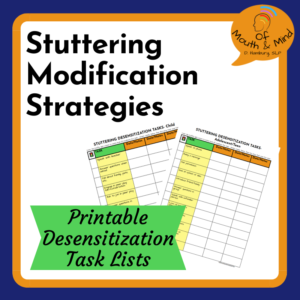Our Role in Stuttering Modification - Desensitization!
As speech-language pathologists, understanding our role in stuttering therapy is critical. Providing stuttering modification instruction and strategies likewise. Our therapy practices and attitudes either help or hinder our client’s understanding of stuttering and more importantly, their self-acceptance. Allowing our clients to identify and discuss their feelings about stuttering and specific speaking situations can be helpful. Practicing or role-playing feared speaking encounters can be used to build confidence. Keep in mind, this is not necessarily to strive for increased fluency but to acknowledge the courage to tackle perceived difficult speaking situations and foster a sense of internal accomplishment. Our goal is to help our clients who stutter to “communicate easier” and “decrease the struggle” (Reeves) when it occurs.
Desensitization is probably the most important metacognitive skill that we can impress on our clients. To read more on this see my blog “Probably the Most Important Stuttering Therapy Strategy!“
Stuttering Desensitization Tasks
To assist you in this role, I have created a resource to support this critical therapy principle. This Stuttering Modification resource provides suggestions for tasks to build desensitization towards stuttering. These are not exhaustive lists but a starter for your therapy sessions. You and your client may want to add specific and personal speaking situations that are perceived or feared. Another suggestion may be other age-appropriate social engagements. Consider the speaking demands in various settings your client frequents (classroom, clubs, home, playground, sports, holiday events, etc.)
I recently came across a simple but effective idea called the Red, Yellow, Green method for stuttering desensitization (Miller). This can easily integrate into your desensitization tasks during therapy. Your client rates desensitization tasks using a traffic light rating system. Green means the client believes the task can be attempted. Yellow means there may be some fear associated with the task, but the challenge may be okay. Red means the client is not ready for this task. Red tasks may also be detrimental to building self-confidence at the current time. They should be saved for later when the client is more prepared and able to take the risk. Using this traffic light method can be used to scaffold conversations regarding feared speaking situations. Additionally, it may help to bring some clarity for both you and your client on their self-awareness. So, I have added a “traffic light” column to the free resource I am providing you to indicate your client’s readiness for individual tasks.
Join my community and enjoy your complimentary 26 page pdf stuttering therapy activity!
Resources:
-Reeves, N. (2021). Stuttering is Verbal Diversity. Webinar: Bright Ideas Media- SLP Summit.
-Yaruss, J.S., (2020). How can we help school-age children become desensitized to stuttering? Stuttering Therapy Resources, Inc. https://stutteringtherapyresources.com/blogs/blog/how-can-we-help-school-age-children-become-desensitized-to-stuttering
-Miller, M. (2022). Red, Yellow, Green. Article for American Institute for Stuttering. Stutteringtreatment.org/blog, January 13, 2022, https://www.stutteringtreatment.org/blog/therapy-thursday-red-yellow-green


One Response